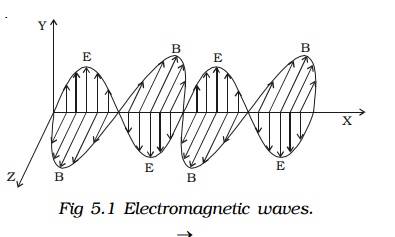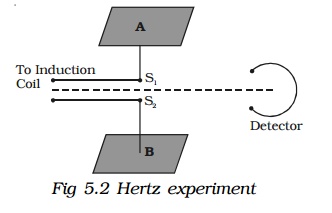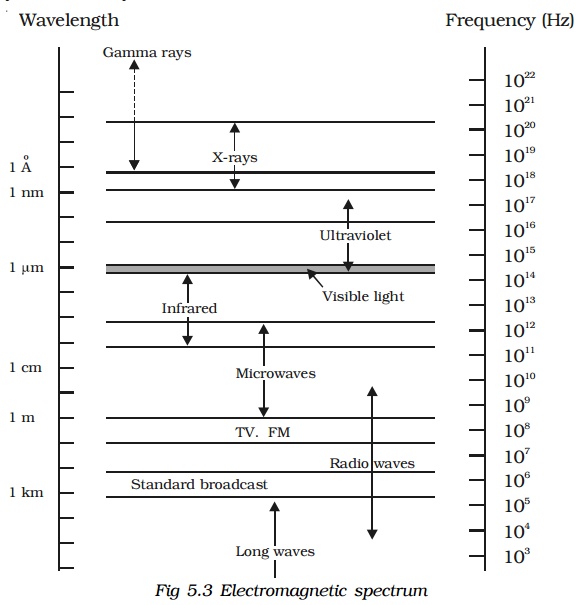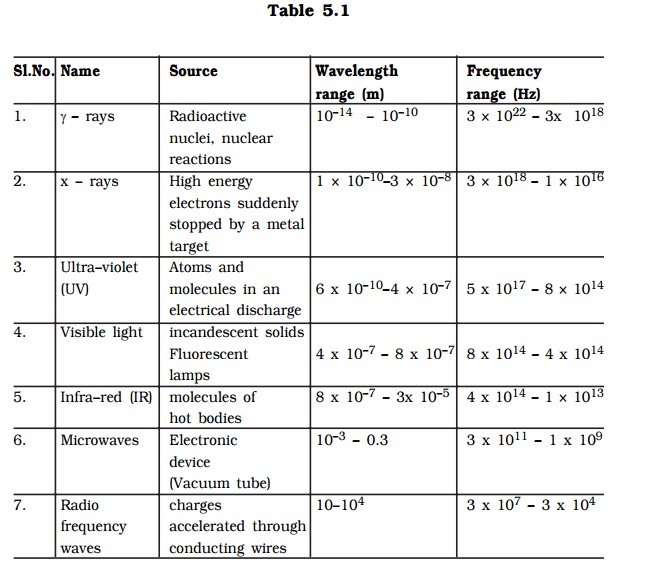Chapter: Physics : Electromagnetic Waves and Wave optics : Higher Secondary(12 Std)
Electromagnetic Waves and Wave optics
Electromagnetic Waves and Wave optics
The phenomenon of Faraday’s electromagnetic induction concludes that a changing magnetic field at a point with time produces an electric field at that point. Maxwell in 1865, pointed out that there is a symmetry in nature (i.e) changing electric field with time at a point produces a magnetic field at that point. It means that a change in one field with time (either electric or magnetic) produces another field. This idea led Maxwell to conclude that the variation in electric and magnetic fields perpendicular to each other, produces electromagnetic disturbances in space. These disturbances have the properties of a wave and propagate through space without any material medium. These waves are called electromagnetic waves.
1. Electromagnetic waves
According to Maxwell, an accelerated charge is a source of electromagnetic radiation.

In an electromagnetic wave, electric and magnetic field vectors are at right angles to each other and both are at right angles to the direction of propagation. They possess the wave character and propagate through free space without any material medium. These waves are transverse in nature.

2. Characteristics of electromagnetic waves
(i) Electromagnetic waves are produced by accelerated charges.
(ii) They do not require any material medium for propagation.
(iii) In an electromagnetic wave, the electric Vector(E) and magnetic Vector(B) field vectors are at right angles to each other and to the direction of propagation. Hence electromagnetic waves are transverse in nature.
(iv) Variation of maxima and minima in both Vector(E) and Vector(B) occur simultaneously.
(v) They travel in vacuum or free space with a velocity 3 × 108 m s−1 given by the relation C = 1/Root(µoεo)
(µo – permeability of free space and εo - permittivity of free space)
(vi) The energy in an electromagnetic wave is equally divided between electric and magnetic field vectors.
(vii) The electromagnetic waves being chargeless, are not deflected by electric and magnetic fields.
3. Hertz experiment
The existence of electromagnetic waves was confirmed experimentally by Hertz in 1888. This experiment is based on the fact that an oscillating electric charge radiates electromagnetic waves. The energy of these waves is due to the kinetic energy of the oscillating charge.

The experimental arrangement is as shown in Fig 5.2. It consists of two metal plates A and B placed at a distance of 60 cm from each other. The metal plates are connected to two polished metal spheres S1 and S2 by means of thick copper wires. Using an induction coil a high potential difference is applied across the small gap between the spheres.
Due to high potential difference across S1 and S2, the air in the small gap between the spheres gets ionized and provides a path for the discharge of the plates. A spark is produced between S1 and S2 and electromagnetic waves of high frequency are radiated. Hertz was able to produce electromagnetic waves of frequency about 5 × 107 Hz.
Here the plates A and B act as a capacitor having small capacitance value C and the connecting wires provide low inductance L. The high frequency oscillation of charges between the plates is given by

4. Electromagnetic Spectrum
After the demonstration of electromagnetic waves by Hertz, electromagnetic waves in different regions of wavelength were produced by different ways of excitation.

The orderly distribution of electromagnetic waves according to their wavelength or frequency is called the electromagnetic spectrum.
Electromagnetic spectrum covers a wide range of wavelengths (or) frequencies. The whole electromagnetic spectrum has been classified into different parts and sub parts, in order of increasing wavelength and type of excitation. All electromagnetic waves travel with the velocity of light. The physical properties of electromagnetic waves are determined by their wavelength and not by their method of excitation. The overlapping in certain parts of the spectrum shows that the particular wave can be produced by different methods.
Table 5.1 shows various regions of electromagnetic spectrum with source, wavelength and frequency ranges of different electromagnetic waves.

5. Uses of electromagnetic spectrum
The following are some of the uses of electromagnetic waves.
1. Radio waves : These waves are used in radio and television communication systems. AM band is from 530 kHz to 1710 kHz. Higher frequencies upto 54 MHz are used for short waves bands.
Television waves range from 54 MHz to 890 MHz. FM band is from 88 MHz to 108 MHz. Cellular phones use radio waves in ultra high frequency (UHF) band.
2. Microwaves : Due to their short wavelengths, they are used in radar communication system. Microwave ovens are an interesting domestic application of these waves.
3. Infra red waves :
i. Infrared lamps are used in physiotherapy.
ii. Infrared photographs are used in weather forecasting.
iii. As infrared radiations are not absorbed by air, thick fog, mist etc, they are used to take photograph of long distance objects.
iv. Infra red absorption spectrum is used to study the molecular structure.
4. Visible light : Visible light emitted or reflected from objects around us provides information about the world. The wavelength range of visible light is 4000 Å to 8000 Å.
5. Ultra−violet radiations
i.They are used to destroy the bacteria and for sterilizing surgical instruments.
ii. These radiations are used in detection of forged documents, finger prints in forensic laboratories.
iii. They are used to preserve the food items.
iv. They help to find the structure of atoms.
6. X rays :
(i) X rays are used as a diagonistic tool in medicine.
(ii) It is used to study the crystal structure in solids.
7. γ−rays : Study of γ rays gives useful information about the nuclear structure and it is used for treatment of cancer.
Related Topics